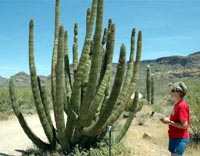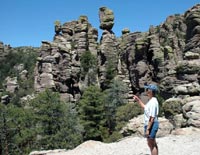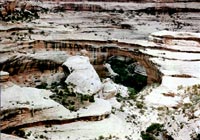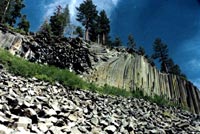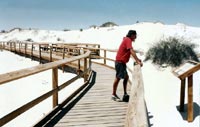| Great
Summer Road Trips Without the Crowds Visiting America's National Monuments by Alice Zyetz |
|
When people think about traveling throughout the United States either by renting or purchasing an RV, one major goal is to see as many national parks as possible. Unfortunately, during the heavy tourist season, the parks are jammed. This month's column introduces you to the joys of visiting the74 U.S. National Monuments. These smaller and often lesser known preserves offer unparalleled beauty and history, often without the crowds so common in the national parks.
SOME OF OUR FAVORITES
George and Jaimie visited Organ Pipe Cactus National Monument in southern Arizona, a park that celebrates the life and landscape of the Sonoran Desert. Many cacti are featured, but the stars are the organ pipe and the saguaro.
The unusual rock formations (called hoodoos) are the main attraction of Chiricahua National Monument in Arizona. Layers of ash deposited by a volcanic eruption 27 million years ago eroded the rock spires. A visitors center describes the life of the Apaches and the soldiers and settlers who followed. Full-time RVer Jim Robinson shares his reaction to his visit to Chiricahua last November:
"This monument is one of a kind and is one of the truly natural wonders of our country. No power lines with poles, or anything else manmade other than absolute necessities for the park, and no four-lane freeways to mar the landscape and detract from its natural glorious beauty. At Massai Point we could see Cochise Stronghold over forty miles away, as well as two other mountain peaks, one 60 miles away and one 81 miles away. To look down on the desert from such a lofty perch must have made the Apaches feel special when they roamed and lived in these mountains."
Natural Bridges National Monument in Utah preserves the natural stone bridges formed when the meandering streams slowly eroded the sandstone canyon walls. Scenic drives include overlooks and features for all visitors to share the beauty. For the more able, there are a number of moderately strenuous hikes into the canyons. Camping is available here.
Devils Postpile National Monument in California demonstrates an unusual geologic feature: columnar basalt. The columns tower 60 feet high and display an unusual symmetry. Nearby are Rainbow Falls, so named because a bright rainbow highlights the falls when the sun is overhead. We were camped for free at an unimproved campground on Hwy 395, just north of Mammoth.
No matter how many photos you view of White Sands National Monument in New Mexico, the experience of being in the midst of the blinding white sand is unlike any other phenomenon I've seen in my travels. It is unremittingly white and pure. The Monument preserves most of the gypsum dune fields that have overwhelmed 275 square miles of desert and the few plants and animals that have survived.
National Monuments provide historical, cultural
and scenic values.
Visiting a National Monument provides a variety of experiences
from the pure beauty of California's Muir
Woods to the unusual rock formations of Arizona's Chiricahua.
Enjoy the historical significance of the Statue
of Liberty and Ellis
Island in New York and New Jersey waters and the prehistoric
remnants of the "big house" in Casa
Grande, Arizona.
For a complete list of National Monuments by state, visit the National Park Obsessed site. Then to find out more detailed information about any site that interests you, go to the government body that administers that monument. Many of the national monuments are administered by the National Park Service. Type in the name of a specific monument, and you can find out about what to see, camping facilities, fees, directions, and handicapped access. When appropriate, the site also provides activities for parents to do with their children and curriculum for teachers to use with their classes.
For a list of monuments by their governing agencies, visit this page on answers.com. The other agencies that administer national monuments are the U.S. Bureau of Land Management, the U.S. Fish and Wildlife Service, and the U.S. Forest Service.
WHAT'S THE DIFFERENCE BETWEEN A NATIONAL MONUMENT AND A NATIONAL PARK?
Generally, national monuments are not as well known, tend to be smaller and have fewer services. Legally, under the Antiquities Act of 1906, the President has the power to grant national monument status to any area of public lands that has historical, cultural and/or scenic value. In contrast, Congress has the power to grant national park status. In practice, size varies from as little as 0.2 acres to over a million acres. Services vary as well. National monuments administered by the National Park Service can offer visitor centers, campgrounds, guided tours, for example. Many national parks got their start as national monuments.
Since the President can act more rapidly than the Congress, the original purpose of the Antiquities Act was to provide a timely option to preserve the historic landmarks before they would be damaged. Interestingly, the decisions were not without dispute from other lawmakers, commercial interests, or local citizens. Many objections were raised when President Clinton declared the Grand Staircase-Escalante area in Utah a national monument. That dispute was just the latest in a long line beginning in 1908 when President Theodore Roosevelt proclaimed the Grand Canyon as a national monument to protect it. It was much later that it achieved national park status.
HOW DOES THIS AFFECT VISITORS?
As travelers and sightseers, we benefit by having a wide variety of beautiful and interesting sites to visit. In addition to the national parks and monuments, we are also blessed with a multitude of recreation areas and historical sites:
National Preserves
National Memorials
National Historic Sites
National Seashores
National Battlefield Parks
National Lakeshores
National Rivers
Wild and Scenic Riverways
National Scenic Trails
National Cemeteries
Wilderness Areas
For more information about these other sites, visit the National Parks Conservation Association's list of parks or "the parks expert"'s complete list of national parks, national monuments, national historical parks, national battlefields, national seashores, and more.
Whether you rent or buy an RV, don't put off
seeing our beautiful country. Happy Trails!
Alice Zyetz
2/18/07
(Links updated 7/20/2021, RTA)

